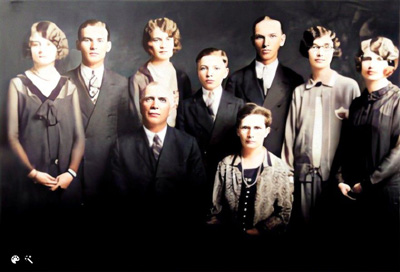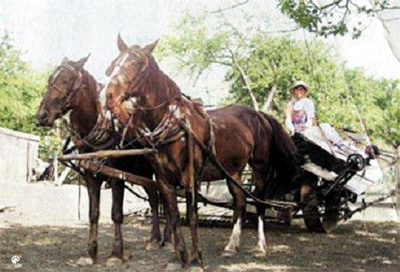The Second Generation
Click to print pdf version of web page
The second generation's patriarch was Folke (Frank) Baumann, who was
married to Lena and owned the farm from 1904 to 1937. Frank, Lena, and
their children are all shown below in the 1920's.

Sitting
in front are Frank Baumann, Sr. and his wife Lena. Standing from
the left are Florence (Uphoff), Frank Jr., Adeline, Alfred, John, Sena
(Telhorster), and Ann.
He farmed the same
acreage and crops and had the same animals. Yet during this generation,
the farming machinery slightly improved. A steel moldboard plow, which
was obviously steel, instead of wood, and developed by John Deere, was
used to plow the land with a horse. Primitive tractors were used by few
farmers; however, Frank did use a tractor towards the end of his
ownership. A reaping machine shown below was used to cut oats, which
were then taken manually to a threshing machine, which separated the
oat grain from straw.
The
oats were still brought from the field by a wagon, or hay-rack. To
harvest corn, the farmers still used the corn-husking peg to cut the
stalks. Toward the end of the generation, the Baumann's had a corn
picker machine to shuck (cut) the corn. There were still no hybrid corn
or insecticides, and manure was still used as land fertilizer.
As Figures A and B
show, production and size of farms were approximately the same as the
first generation even though there was a small change in methods of
production. From 1870 to 1930, covering two Baumann generations, the
average bushels of corn per acre remained around 25 bushels. Hence, the
farmers needed something more to increase their production.
The
landscape and daily life also slightly changed in the second
generation. The farmland was now completely tiled and had the same
buildings, except that a garage was built for the new Model T Ford. But
they still mainly used a horse and buggy. There were more shade
trees and fruit trees had been planted. The pasture remained the same
size. There was still no electricity or indoor plumbing; therefore,
they still used kerosene lamps, an out-house, a windmill, a cistern,
and coal and cobs to heat the house.
Frank and Lena had seven children who were educated in English. The
family began speaking English and was bilingual. The family's busy
daily routine remained the same as the first generation.

